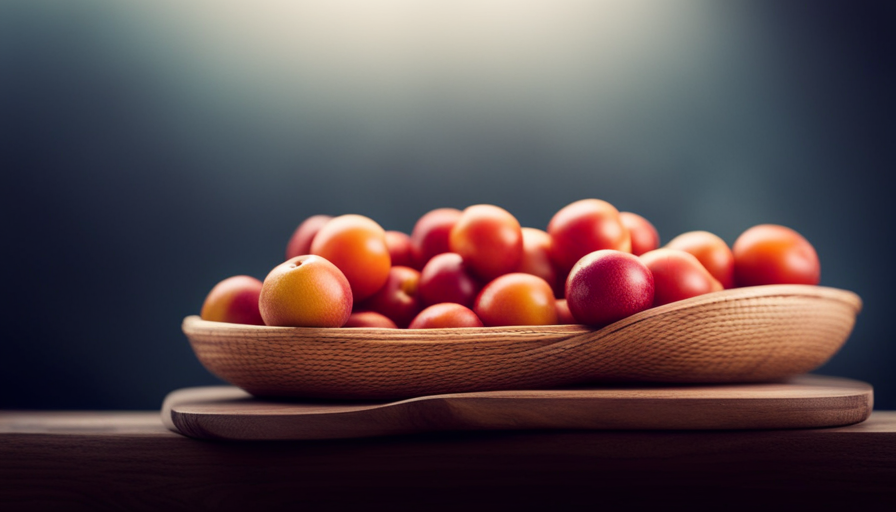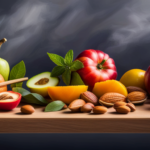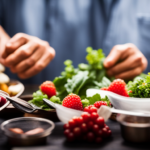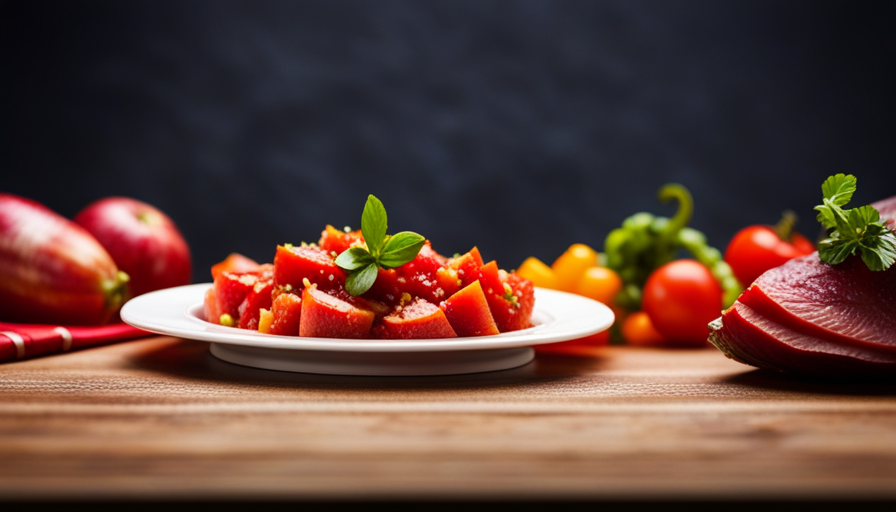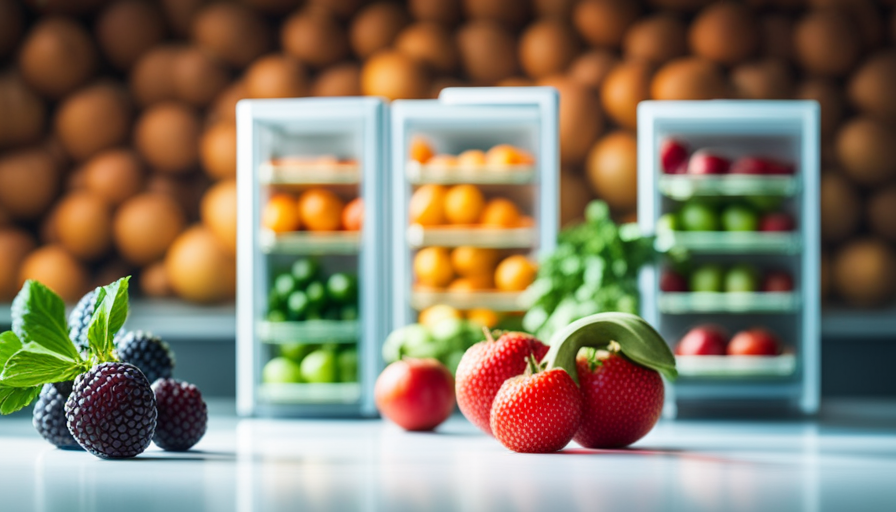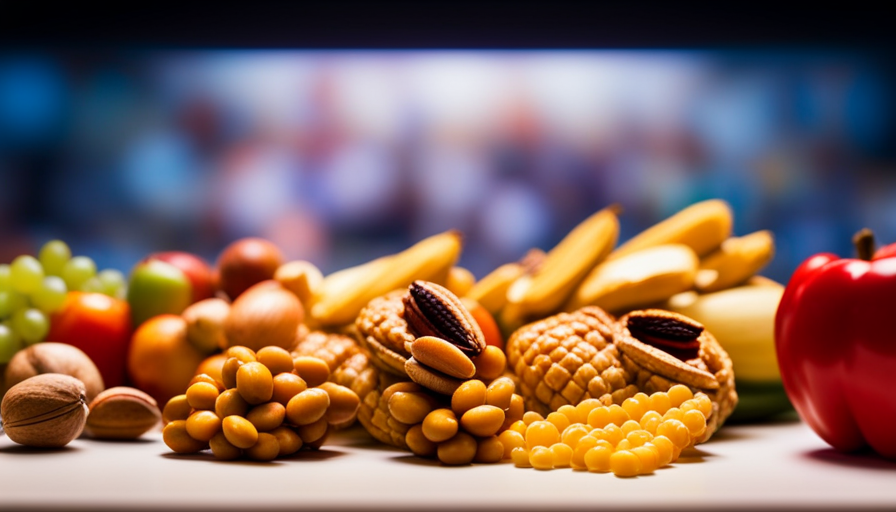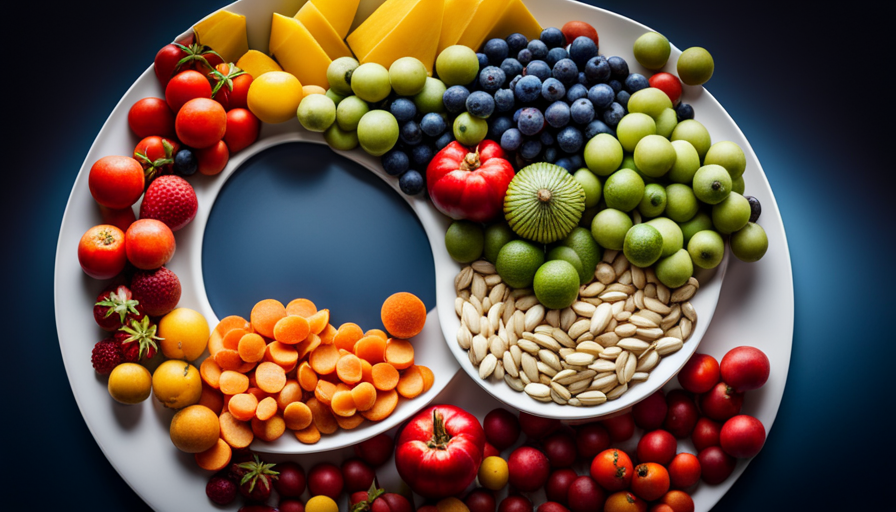A well-known saying goes, ‘What you eat defines you.’ For those who prioritize the consumption of natural, unprocessed foods, learning to recognize raw food is a critical ability. Whether you care deeply about your health or you’re just interested in exploring the advantages of consuming raw food, knowing how to spot it can significantly impact the choices you make regarding your lifestyle.
Raw food, in its purest form, is uncooked and unprocessed, preserving vital nutrients and enzymes that can be lost through cooking. But how do you spot raw food amidst a sea of options? This article will guide you through the process, providing valuable tips and techniques to help you discern raw food from its cooked counterparts. From examining texture and appearance to paying attention to smell, we’ll explore the various methods you can use to confidently identify raw food and make informed choices for a healthier, more vibrant you.
Key Takeaways
- Look for keywords like ‘raw,’ ‘uncooked,’ or ‘unprocessed’ in labels
- Check for cooking instructions on the label
- Look for packaging that emphasizes freshness and minimal processing
- Engage with farmers at farmers markets for information about the food
Understanding the Benefits of Raw Food
If you’re curious about the health advantages of raw food, you’re in for a treat! Understanding the nutritional value of raw food can help you make informed choices about your diet.
Raw food is packed with essential vitamins, minerals, and enzymes that can support your overall well-being. Unlike cooked food, which may lose some of its nutrients during the cooking process, raw food retains its natural goodness.
Exploring new recipes can be a fun and exciting way to incorporate more raw food into your diet. There are countless delicious and nutritious raw food recipes available that can satisfy your taste buds and nourish your body. From refreshing salads to vibrant smoothies, the possibilities are endless.
Raw food enthusiasts often report increased energy levels, improved digestion, and clearer skin when they incorporate more raw food into their diet. Additionally, raw food can be a great way to increase your intake of fruits and vegetables, which are rich in antioxidants and fiber.
So, if you’re looking to boost your nutritional intake and explore new flavors, give raw food a try. You might just discover a whole new world of delicious and nutritious meals!
Knowing the Difference: Raw vs. Cooked
To distinguish between cooked and uncooked items, you must rely on your senses and look for subtle changes in texture, color, and aroma. Raw foods have a distinct texture that is often crisp and firm, whereas cooked foods tend to be softer and more tender. When it comes to color, raw foods typically have a vibrant and natural appearance, while cooked foods may appear more dull or browned. Additionally, the aroma of raw food is often fresh and earthy, while cooked food may have a richer and more fragrant smell.
Understanding the differences between raw and cooked foods is essential when it comes to knowing the benefits of raw food. Raw food enthusiasts believe that cooking can destroy important nutrients and enzymes that are present in their natural state. These nutrients are said to provide numerous health benefits, such as improved digestion and increased energy levels. Furthermore, raw food is known for its unique taste and flavor. Raw fruits and vegetables often have a natural sweetness and freshness that can be lost through the cooking process.
To help you visualize the differences between raw and cooked food, here is a table that highlights some key contrasts:
| Raw Food | Cooked Food |
|---|---|
| Crisp | Soft |
| Vibrant | Dull |
| Fresh | Fragrant |
By understanding these subtle differences, you can easily spot raw food and make informed choices about incorporating it into your diet.
Examining Texture and Appearance
Examining the texture and appearance of ingredients allows you to truly taste the essence of a dish and appreciate its culinary artistry. When it comes to spotting raw food, texture and appearance are key factors to consider.
Raw ingredients often have a crisp and firm texture, while cooked ones tend to be softer and more tender. For example, raw vegetables like carrots and cucumbers have a crunchy texture that adds freshness to salads, while cooked vegetables become softer and more easily chewed.
In terms of appearance, raw food usually retains its vibrant colors and natural shape. Raw fruits and vegetables have a bright and glossy appearance, indicating their freshness and nutritional value. On the other hand, cooked food may lose some of its color and become more dull-looking. This is because the heat breaks down the pigments in the food, causing a change in appearance.
Examining taste is another way to determine whether food is raw or cooked. Raw food often has a more intense and natural flavor compared to cooked food. Heating can alter the taste and texture of ingredients, sometimes enhancing it but also potentially diminishing it. Considering the nutritional value, raw food typically retains more of its vitamins, minerals, and enzymes, which can be lost through cooking.
By examining the texture, appearance, and taste of ingredients, you can easily spot whether they are raw or cooked. This knowledge will help you appreciate the culinary artistry behind a dish and make informed choices about the food you consume.
Paying Attention to Smell
Paying attention to the aroma of ingredients adds another layer of sensory experience to fully appreciate the culinary artistry of a dish.
When it comes to spotting raw food, paying attention to your sense of smell is crucial. The smell of raw ingredients can tell you a lot about their freshness and quality.
First and foremost, trust your nose. If something smells off or unpleasant, it’s a clear sign that the food is not fresh. For example, raw meat should have a neutral, slightly sweet smell. If it has a strong, rancid odor, it’s likely spoiled and should be discarded immediately.
Additionally, certain ingredients have distinct smells that can help you identify if they are raw or cooked. Fruits and vegetables, for instance, should have a fresh and vibrant aroma. If they smell dull or musty, it could indicate that they are past their prime.
Furthermore, paying attention to the intensity of the smell can also provide valuable information. A strong, overpowering smell can suggest that the food is overripe or starting to decompose.
Paying attention to your sense of smell is a valuable tool in spotting raw food. By trusting your nose and being aware of the different smells associated with fresh ingredients, you can ensure that your dishes are made with the highest quality ingredients.
Checking for Heating or Cooking Signs
Keep your eyes peeled for the telltale signs that indicate whether or not the ingredients have been heated or cooked, like a sizzling sound or a golden brown color. When checking for heating indications, look for charred or blackened areas on the food. This can be a sign that the food has been exposed to high heat, either through grilling, baking, or frying. Additionally, pay attention to the texture of the food. Cooked food tends to have a softer texture compared to raw food. If the food feels tender or easily breaks apart, it’s likely that it’s been cooked.
Another way to spot cooking signs is by examining the color of the food. When food is heated or cooked, it often undergoes a chemical reaction called the Maillard reaction, which results in a golden brown color. Keep an eye out for this color change, as it can indicate that the food has been cooked.
In some cases, you may also notice a change in aroma when food is cooked. The heating process can release certain compounds that contribute to the characteristic smell of cooked food. Take a moment to sniff the food and see if you can detect any pleasant or appetizing smells.
By paying attention to heating indications and cooking signs, you can easily spot whether or not the food you’re about to consume has been cooked or is still raw. This knowledge can help you make informed choices about the safety and quality of the food you eat.
Reading Labels and Packaging
Take a moment to check out the labels and packaging, and you’ll be amazed at the valuable information that can help you make informed choices about what you’re putting in your body.
When it comes to spotting raw food, reading labels and understanding packaging is key. Labels provide important details about the product, such as ingredients, nutritional information, and storage instructions. By reading these labels, you can easily determine if the food is raw or not.
Start by looking for keywords like ‘raw,’ ‘uncooked,’ or ‘unprocessed’ on the label. These words indicate that the food hasn’t undergone any heating or cooking processes. Additionally, check for any cooking instructions. If the label advises cooking or heating, it’s a clear sign that the food isn’t raw.
Understanding packaging is also essential in spotting raw food. Raw food is often packaged in ways that preserve its freshness and natural state. Look for packaging that emphasizes freshness, such as vacuum-sealed bags or containers with minimal processing. Avoid packaging that indicates the food has been cooked or processed, such as canned or pre-packaged meals.
By carefully reading labels and understanding packaging, you can confidently identify raw food and make healthier choices for your body.
Asking for Information at Farmers Markets
Engage with the farmers at the market and ask them questions about their produce, allowing their passion and knowledge to inspire you to make informed choices for your health.
Farmers markets are a great place to not only support local agriculture but also to gather information about the food you’re buying. Here are some tips for asking for information at farmers markets:
-
Ask about farming practices: Inquire about how the produce is grown and if any pesticides or fertilizers are used. Farmers who adhere to organic or sustainable farming practices will be proud to share this information with you.
-
Inquire about the freshness: Ask the farmers how recently the produce was harvested. Freshness is key when it comes to raw food, as it retains more nutrients and flavor.
-
Seek advice on preparation: Farmers often have a wealth of knowledge on how to prepare their produce. Ask them for tips on cooking methods, recipes, and any other advice they can offer.
Building relationships with the farmers at the market not only allows you to gather information but also fosters a sense of community. By engaging with them, you’re supporting their livelihood and becoming more connected to the food you eat. So, don’t be shy, strike up a conversation, and enjoy the benefits of information sharing and building relationships at your local farmers market.
Understanding the Importance of Sourcing
Make sure to understand the significance of where your food comes from, as it directly impacts both your health and the environment. Sourcing quality food is essential for maintaining a healthy lifestyle.
When it comes to raw food, the importance of sourcing becomes even more critical. Raw food is not processed or cooked, so any contaminants or impurities present in the sourcing process can directly affect your health.
One aspect of sourcing quality raw food is ethical sourcing. Ethical sourcing refers to the process of obtaining food in a way that is responsible and sustainable. This means ensuring that the food is produced in an environmentally friendly manner, without causing harm to animals or exploiting workers.
When you choose ethically sourced raw food, you are not only supporting your own health but also contributing to a more sustainable and fair food system.
To ensure you are sourcing quality raw food, it is important to research the farms and suppliers you buy from. Look for certifications or labels that indicate ethical sourcing practices. Additionally, consider buying directly from local farmers or participating in community-supported agriculture programs.
By doing so, you can have confidence in the quality and sourcing of the raw food you consume, promoting your own well-being and the well-being of the planet.
Utilizing Food Safety Guidelines
Utilizing food safety guidelines is crucial for ensuring the well-being of both ourselves and the environment. When it comes to handling raw food, following proper protocols is essential to prevent cross-contamination and maintain the freshness of ingredients.
Here are four important food safety guidelines to keep in mind:
-
Separate: Always keep raw food separate from ready-to-eat food to avoid cross-contamination. This means using separate cutting boards, utensils, and plates for raw meat, poultry, and seafood.
-
Clean: Cleanliness is key when it comes to handling raw food. Wash your hands thoroughly with soap and warm water before and after handling raw ingredients. Additionally, make sure to clean all surfaces, utensils, and equipment that come into contact with raw food.
-
Chill: Proper storage temperatures are crucial for preventing the growth of harmful bacteria. Refrigerate raw food promptly and keep it at or below 40°F (4°C) to maintain its quality and reduce the risk of foodborne illnesses.
-
Cook: Cooking raw food to the right internal temperature is essential for killing bacteria. Use a food thermometer to ensure that meats, poultry, and seafood reach the appropriate temperature to ensure their safety.
By following these food safety guidelines, you can minimize the risk of foodborne illnesses and ensure that the raw food you handle is safe for consumption.
Exploring Raw Food Preparation Methods
One popular method for preparing raw ingredients is through the use of fermentation, which can transform ordinary vegetables into tangy and probiotic-rich sauerkraut that aids in digestion and promotes gut health. Fermentation is a natural process that breaks down sugars in food using bacteria and yeast. It not only adds flavor but also increases the nutritional value of the ingredients. To ensure raw food safety during fermentation, it’s important to follow proper guidelines such as using clean utensils and containers, keeping the ingredients submerged in liquid, and allowing the fermentation process to occur at the right temperature.
Here is a table that highlights some popular raw food recipes that can be prepared using fermentation:
| Raw Food Recipe | Ingredients | Fermentation Time |
|---|---|---|
| Sauerkraut | Cabbage | 1-4 weeks |
| Kimchi | Napa cabbage, radish, scallions | 2-5 days |
| Fermented pickles | Cucumbers, dill, garlic | 1-2 weeks |
These recipes not only provide a delicious way to enjoy raw ingredients but also offer the benefits of probiotics, enzymes, and vitamins. Remember to always follow proper food safety guidelines when preparing raw food to ensure a healthy and enjoyable culinary experience.
Frequently Asked Questions
Can I eat raw meat?
Yes, you can eat raw meat, but it’s important to consider raw meat safety. Cooking meat helps kill harmful bacteria and parasites that may be present, reducing the risk of foodborne illnesses. Cooking also enhances the flavor and texture of meat. However, if you choose to eat raw meat, make sure to source it from a reputable supplier, handle it properly, and be aware of the potential risks involved.
How can I tell if a food has been cooked before?
To determine if a food has been cooked before, there are a few signs to look out for. First, check the texture. Cooked food is usually softer and easier to chew compared to raw food.
Additionally, cooked food often has a distinct aroma and a change in color. It’s important to ensure food is cooked properly as it eliminates harmful bacteria that can cause food poisoning symptoms. Cooking also enhances the flavor and nutritional benefits of food.
Are there any health risks associated with consuming raw food?
Consuming raw food can have health risks because it may contain harmful bacteria, viruses, or parasites that can cause foodborne illnesses. However, there are also potential health benefits to eating raw food.
Raw fruits and vegetables retain their natural enzymes, vitamins, and minerals, which can contribute to overall nutritional value.
It’s important to properly wash and handle raw food to minimize the risk of contamination and ensure its safety for consumption.
Can I eat raw eggs?
You’re walking on thin ice if you decide to eat raw eggs. While some may argue that it’s a culinary adventure, there are significant health risks involved. Raw eggs can contain bacteria like Salmonella, which can lead to food poisoning. To ensure your safety, it’s best to cook eggs thoroughly. If you’re looking for alternatives, consider using pasteurized eggs or egg substitutes that are specifically made for consumption without cooking.
Are there any specific food safety guidelines I should follow when handling raw food?
When handling raw food, it’s important to follow specific food safety guidelines to ensure your health and prevent contamination. Always wash your hands thoroughly before and after handling raw food. Use separate cutting boards and utensils for raw and cooked foods to avoid cross-contamination. Keep raw meats and seafood refrigerated at or below 40°F (4°C) to inhibit bacterial growth. Cook raw foods to the appropriate internal temperature to kill any harmful bacteria.
What Are the Signs of Spoiled Raw Food?
When identifying raw or cooked food, signs of spoiled raw food include a strong, unpleasant odor, changes in color or texture, and the presence of mold or slime. Always inspect raw food before consuming it, as consuming spoiled food can lead to food poisoning and other health issues.
Conclusion
In conclusion, by following these guidelines, you can easily spot raw food and ensure that you’re getting the most out of its benefits.
Understanding the difference between raw and cooked food, examining its texture and appearance, and paying attention to its smell are all effective ways to determine if a food is raw.
Additionally, asking for information at farmers markets and understanding the importance of sourcing can further help in identifying raw food.
By utilizing food safety guidelines and exploring raw food preparation methods, you can enjoy the health benefits that raw food has to offer.

